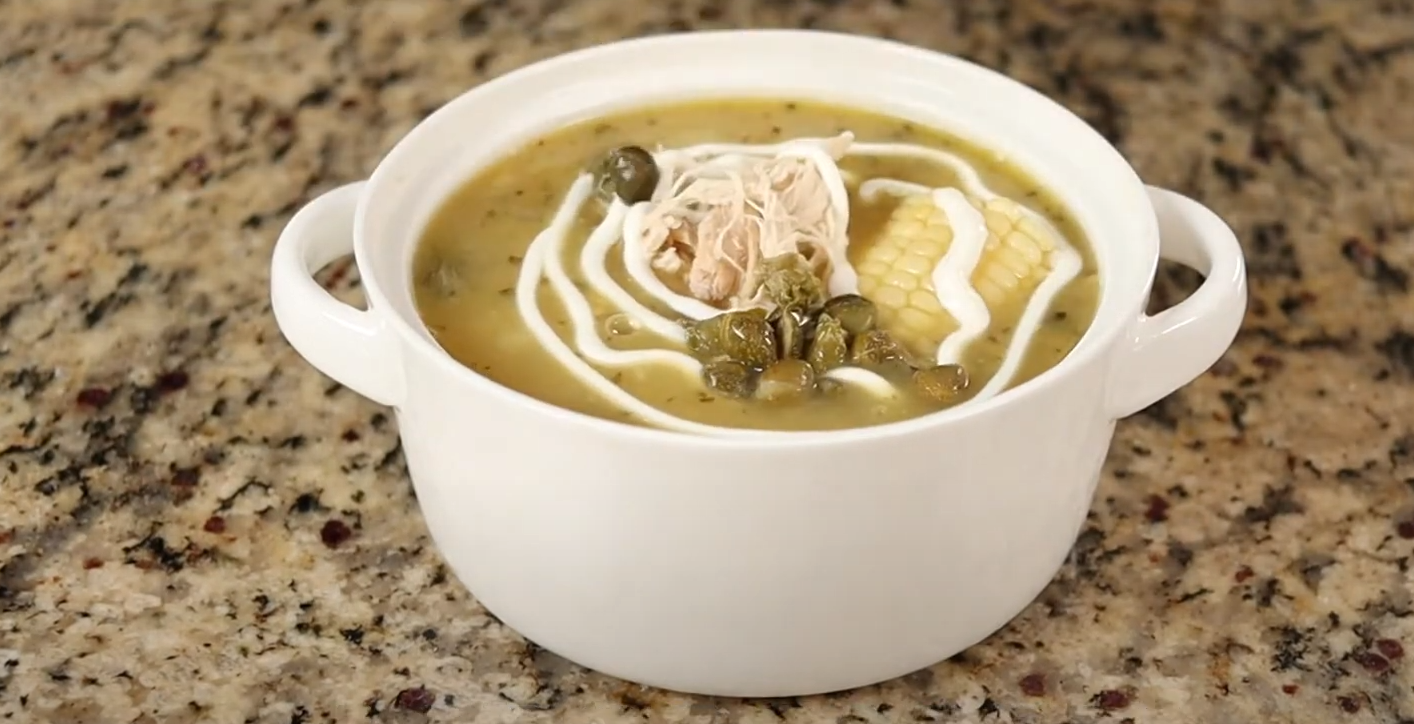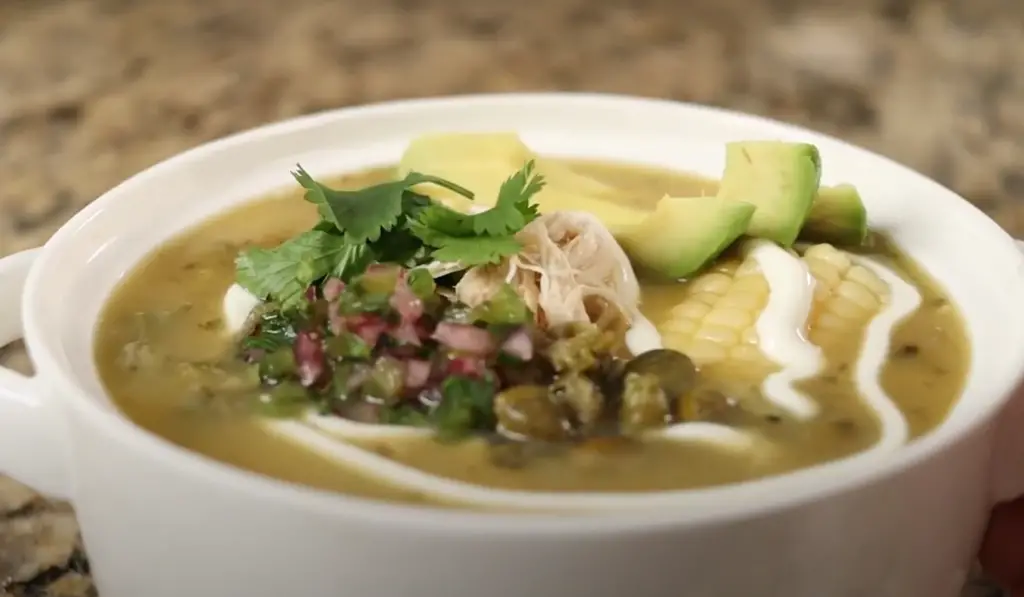Ajiaco, a name that resonates with warmth and tradition, stands as a culinary emblem in the heart of Latin America. This dish, more than just a mere soup, is a celebration of culture, history, and the rich tapestry of flavors that define the regions it hails from. In this comprehensive exploration, we delve into the world of Ajiaco, uncovering its roots, variations, and the unique place it holds in the kitchens and hearts of many.
At its core, Ajiaco is a hearty, comforting soup, primarily known for its popularity in Colombia, Peru, and Cuba. Each region brings its own twist to the recipe, weaving in local ingredients and culinary traditions. The Colombian version, particularly from Bogotá, is famed for its use of three types of potatoes and guascas, a local herb that imparts a distinctive flavor. The Peruvian and Cuban variants, while sharing the name, offer different taste profiles, showcasing the diversity of Latin American cuisine.
As we embark on this flavorful journey, we will explore the nuances that make Ajiaco a beloved dish. From its humble beginnings to its rise as a culinary staple, Ajiaco’s story is as rich and diverse as its ingredients. Join us as we unravel the layers of this delectable dish, understanding what makes it a must-try for anyone who cherishes the art of cooking and the joy of a well-prepared meal.
What is Ajiaco?
Ajiaco, at its simplest, is a traditional soup, but its complexity lies in the symphony of ingredients and the cultural stories it carries. This dish is a quintessential example of how a simple meal can transcend culinary boundaries, becoming a symbol of national pride and cultural identity.
Key Ingredients and Their Roles
- Chicken: The foundation of the soup, providing a rich, meaty base.
- Potatoes: A mix of different types, each lending its own texture and flavor.
- Guascas: A unique herb that is the defining feature of the Colombian Ajiaco, offering an earthy and slightly floral taste.
- Corn: Adding sweetness and a delightful crunch.
- Accompaniments: Typically served with capers, avocado, cream, and sometimes rice, enhancing the overall flavor and richness.
Variations Across Countries
- Colombian Ajiaco: Known as Ajiaco Bogotano, this version is a hearty blend of chicken, three types of potatoes, and guascas. It’s a staple in Bogotá and a source of regional pride.
- Peruvian Ajiaco: In Peru, Ajiaco takes a different form, often featuring potatoes and chili, with variations including chicken or rabbit stew.
- Cuban Ajiaco: A stew rather than a soup, the Cuban version is a robust mix of various meats and vegetables, reflecting the island’s diverse cultural influences.
Each variant tells a story of the land it comes from, the people who cherish it, and the history that shaped it. It’s a dish that has evolved over centuries, adapting to the tastes and ingredients of each region, yet always retaining its soul-warming essence. As we delve deeper into the origins and cultural significance of Ajiaco, we begin to appreciate not just the dish itself, but the rich tapestry of Latin American culinary traditions.
The Origin of Ajiaco
The story begins in the tapestry of Latin American history, where culinary traditions are as diverse as the cultures themselves. Tracing its roots back to the pre-Columbian era, Ajiaco is more than a dish; it’s a historical narrative on a plate. The word ‘Ajiaco’ itself is believed to derive from ‘Aji’, a term used by the indigenous Taino people, referring to the hot peppers that were a staple in their diet. For a detailed exploration of Ajiaco’s history, from pre-Columbian times to modern Latin American variations, see the Wikipedia page on Ajiaco. It provides an extensive look at the dish’s evolution, reflecting the region’s diverse culinary traditions.
A Culinary Journey Through Time
- Pre-Columbian Origins: Ajiaco’s earliest versions likely originated with the indigenous communities of the Caribbean, particularly the Taino tribe. Initially, it was a simple stew made with available local ingredients, including the aji pepper.
- Colonial Influences: With the arrival of Spanish colonizers and African slaves, Ajiaco evolved, incorporating new ingredients like chicken and European vegetables, transforming into the richer, more complex dish we know today.
Geographical Spread and Evolution
- Colombia: In Colombia, Ajiaco became synonymous with the capital, Bogotá. The cool Andean climate lent itself perfectly to this hearty, comforting dish.
- Peru and Cuba: As Ajiaco traveled to Peru and Cuba, it morphed to suit local tastes and available ingredients, leading to the distinct variations found in these countries today.
Understanding the origin of Ajiaco is to appreciate the confluence of different cultures and the adaptability of culinary traditions. It’s a dish that has stood the test of time, evolving while maintaining its essence, a testament to the enduring power of food in cultural expression.
Colombian Cuisine

In Colombia, Ajiaco is not just a dish; it’s a symbol of national identity, particularly in Bogotá. Known as Ajiaco Bogotano, this version is a rich, hearty soup that reflects the diversity of Colombia’s landscape and its people.
The Quintessential Ajiaco Bogotano
- Ingredients: The soul of Ajiaco Bogotano lies in its use of three types of potatoes – red, white, and the Andean papa criolla. These, along with chicken, corn, and guascas, create a unique blend of flavors and textures.
- Preparation: The process of making Ajiaco is a labor of love. It begins with simmering chicken to create a flavorful broth, followed by the gradual addition of the different potatoes, corn, and guascas. The result is a thick, creamy soup, rich in layers of flavor.
- Serving: Traditionally, chefs or home cooks serve Ajiaco with a dollop of cream, capers, and avocado slices on the side, which adds richness and depth to each spoonful.
Cultural Significance
- A Dish for All Occasions: In Colombian culture, Ajiaco is more than just a meal; it’s a centerpiece for family gatherings, celebrations, and even everyday dining. It’s a dish that brings people together, symbolizing warmth and hospitality.
- A Reflection of Colombian Diversity: Ajiaco’s ingredients represent the varied geography of Colombia, from the Andean highlands to the coastal regions. This diversity is a point of pride and is celebrated through this beloved dish.
Ajiaco in Colombian cuisine is a story of tradition, unity, and the enduring power of food to convey a sense of place and identity. It’s a dish that every Colombian holds dear, and one that encourages visitors to the country to experience it, to truly understand the heart of Colombian culture.
Variations in Latin America
Ajiaco, while deeply rooted in Colombian culture, has spread its culinary wings across Latin America, each region adding its own unique flair to this classic dish. These variations not only highlight the versatility of Ajiaco but also reflect the rich tapestry of Latin American culinary traditions.
Peruvian Ajiaco
- Distinctive Features: Unlike its Colombian counterpart, the Peruvian Ajiaco is often less of a soup and more of a stew. It commonly features potatoes and aji peppers, with some versions including chicken or rabbit.
- Regional Variations: In Peru, Ajiaco can vary significantly from one region to another, showcasing the country’s diverse culinary landscape.
Cuban Ajiaco
- A Melting Pot of Flavors: The Cuban version of Ajiaco stands out as a robust, hearty stew. It’s a fusion of meats – typically pork, beef, and chicken – and a variety of vegetables, embodying the island’s rich cultural heritage.
- Cultural Significance: In Cuba, Ajiaco is more than a dish; it’s a symbol of national identity, representing the blending of Spanish, African, and indigenous influences.
Shared Elements and Diverging Paths
- Common Ground: Across all variations, Ajiaco remains a comforting, hearty dish, often served as a symbol of hospitality and warmth.
- Diverse Interpretations: Each country’s take on Ajiaco is a reflection of its unique history, climate, and cultural influences, making the dish a culinary journey through Latin America.
Exploring the variations of Ajiaco across Latin America is not just a culinary adventure but a journey through the history and culture of this vibrant region. Each bowl tells a story, a delicious narrative of the people and the land from which it originates.
Cooking Ajiaco: Step-by-Step Guide

Creating a traditional Ajiaco, particularly the Colombian version, is an exercise in patience and love. Here, we provide a detailed guide to help you bring this comforting dish to your table.
Ingredients and Substitutes
- Chicken: Essential for the broth; can be substituted with a vegetarian broth for a meat-free version.
- Potatoes: Use a mix of red, white, and Andean papa criolla for authenticity. Substitutes can include Yukon gold or russet potatoes.
- Guascas: This herb is key to Ajiaco’s unique flavor. If unavailable, try dried oregano as a substitute, though the flavor will differ.
- Corn: Fresh corn on the cob is preferred, but frozen can be used as an alternative.
To ensure you perfectly cook your chicken for Ajiaco, discover how to master the art of making it moist and flavorful every time.”
Cooking Instructions
- Broth Preparation: Start by simmering the chicken in water with salt and garlic to create a flavorful broth.
- Adding Potatoes: Introduce the different types of potatoes. As they cook, they will break down, thickening the soup.
- Incorporating Guascas: Add guascas midway through cooking to infuse the broth with its distinctive flavor.
- Final Touches: Add the corn towards the end of cooking and adjust seasoning to taste.
Serving Suggestions
- Serve Ajiaco hot, garnished with cream, capers, and avocado slices.
- Accompany with a side of white rice or a simple salad for a complete meal.
Tips and Tricks
- Balancing Flavors: The key to a perfect Ajiaco is the balance of flavors. Be mindful of the seasoning, adjusting as needed.
- Texture: The soup should be hearty but not overly thick. Adjust the amount of water or broth to achieve the desired consistency.
Cooking Ajiaco at home is a rewarding experience, offering a taste of Latin American culture right in your kitchen. Whether you stick to the traditional recipe or add your own twist, the result is sure to be a comforting, flavorful dish that warms the soul.
Nutritional Value
Ajiaco is not only a feast for the senses but also a nutritious meal that offers a range of health benefits. This wholesome soup combines a variety of ingredients that contribute to its nutritional profile.
Key Nutritional Aspects
- Rich in Proteins: The chicken in Ajiaco provides a good source of lean protein, essential for muscle growth and repair.
- High in Vitamins and Minerals: Potatoes and corn, key ingredients in Ajiaco, are rich in vitamins C and B6, potassium, and magnesium.
- Dietary Fiber: The variety of vegetables used in Ajiaco contributes to its high fiber content, aiding in digestion and promoting gut health.
Dietary Considerations
- Gluten-Free: Naturally gluten-free, Ajiaco is suitable for those with gluten sensitivities or celiac disease.
- Adaptable for Different Diets: With minor adjustments, such as using a vegetarian broth, Ajiaco can be adapted to fit vegetarian or vegan diets.
The nutritional value of Ajiaco makes it not just a comforting meal but also a healthy choice for those looking for a balanced diet. Its combination of proteins, vitamins, and fiber ensures that it is as nourishing as it is delicious.
Ajiaco in Popular Culture
Ajiaco has transcended the boundaries of the kitchen, making its mark in popular culture and media. This dish has been featured in various forms, highlighting its cultural significance and widespread appeal.
Media and Television
- Ajiaco has been showcased in international cooking shows and documentaries, often highlighting its cultural roots and regional variations. For instance, the Netflix series “Street Food: Latin America” features Ajiaco, emphasizing its role in Colombian street food culture.
Festivals and Celebrations
- In many Latin American countries, Ajiaco is more than just a dish; it’s a part of celebrations and festivals. Cooks often prepare it in large quantities and share it among communities, symbolizing unity and tradition.
Culinary Awards
- Ajiaco has gained recognition in culinary competitions, with chefs and home cooks alike showcasing their versions of this traditional dish. These events often highlight the versatility and rich history of Ajiaco.
Ajiaco’s presence in popular culture is a testament to its enduring appeal and cultural significance. It’s a dish that tells a story, one that resonates with people across different countries and backgrounds.
Where to Find the Best Ajiaco
For those seeking to experience the authentic taste of Ajiaco, knowing where to find the best rendition of this iconic dish is key. From bustling street vendors to acclaimed restaurants, Ajiaco can be savored in various settings, each offering a unique culinary experience.
Famous Ajiaco Restaurants and Locations
- Bogotá, Colombia: As the heartland of Ajiaco, Bogotá boasts numerous restaurants that serve this traditional dish. La Puerta Falsa, one of the city’s oldest eateries, is renowned for its classic Ajiaco Bogotano.
- Lima, Peru: In Lima, Ajiaco takes a different form, and local eateries offer their unique takes on this Peruvian variant, often featuring Andean potatoes and aji peppers.
- Havana, Cuba: For a taste of Cuban Ajiaco, Havana’s local paladares (small, family-run restaurants) offer hearty versions, reflecting the island’s diverse culinary influences.
Tips for Finding Authentic Ajiaco
- Local Recommendations: Often, the best Ajiaco is found in less touristy areas. Ask locals for their favorite spots to enjoy an authentic experience.
- Food Festivals: Food festivals and culinary events are great places to sample different versions of Ajiaco, prepared by expert chefs and traditional cooks.
Whether you’re wandering the streets of Bogotá or exploring the culinary scene in Lima or Havana, the quest for the best Ajiaco is an adventure in itself, offering a taste of the rich culinary heritage of Latin America.
Making Ajiaco at Home: Tips and Tricks
Creating Ajiaco in your own kitchen can be a deeply rewarding experience, allowing you to bring a piece of Latin American culinary tradition into your home. Here are some expert tips and common mistakes to avoid for a successful Ajiaco preparation.
Expert Advice for First-Time Cooks
- Quality of Ingredients: The flavor of Ajiaco heavily depends on the quality of the ingredients. Use fresh vegetables and high-quality chicken for the best results.
- Patience with the Process: Ajiaco is a dish that requires time and patience. Allow the flavors to develop slowly for a rich and satisfying soup.
Common Mistakes to Avoid
- Overcooking the Potatoes: Be careful not to overcook the potatoes, as they should retain some texture and not completely disintegrate into the broth.
- Skimping on Guascas: Guascas is a key ingredient in Colombian Ajiaco. Don’t skimp on it, as it provides the distinctive flavor that sets this dish apart.
By following these tips and avoiding common pitfalls, you can create a delicious Ajiaco that captures the essence of this beloved Latin American dish. Whether you’re an experienced cook or a novice in the kitchen, the process of making Ajiaco is as enjoyable as savoring the final product.
FAQs
What is the main difference between Colombian, Peruvian, and Cuban Ajiaco?
- A: The main difference lies in the ingredients and preparation. Colombian Ajiaco is a chicken and potato soup flavored with guascas, Peruvian Ajiaco often includes potatoes and aji peppers and may feature chicken or rabbit, while Cuban Ajiaco is a hearty stew with various meats and vegetables.
Can Ajiaco be made vegetarian?
- A: Yes, Ajiaco can be adapted for a vegetarian diet by using vegetable broth instead of chicken and omitting the meat. The essence of the dish, particularly the use of different potatoes and guascas, still makes for a flavorful vegetarian soup.
What are guascas, and is there a substitute for them?
- A: Guascas is a herb native to Colombia, crucial for the authentic flavor of Colombian Ajiaco. If unavailable, dried oregano can be used as a substitute, though it will alter the taste slightly.
Is Ajiaco gluten-free?
- A: Yes, traditional Ajiaco is naturally gluten-free, as it primarily consists of chicken, potatoes, and corn, making it suitable for those with gluten sensitivities.
How long can Ajiaco be stored?
- A: Ajiaco can be refrigerated for up to 3-4 days. It’s recommended to store the soup and garnishes separately. Reheat gently before serving.
Conclusion
Ajiaco, with its rich flavors and deep cultural roots, is more than just a dish; it’s a culinary journey through Latin America. From the hearty Ajiaco Bogotano to the diverse interpretations in Peru and Cuba, this dish embodies the spirit of its people and the richness of their traditions. Whether enjoyed in a bustling Bogotá restaurant, a cozy Lima eatery, or the comfort of your home, Ajiaco offers a warm embrace of flavors and history. It’s a testament to the power of food in bringing people together and preserving cultural heritage.
